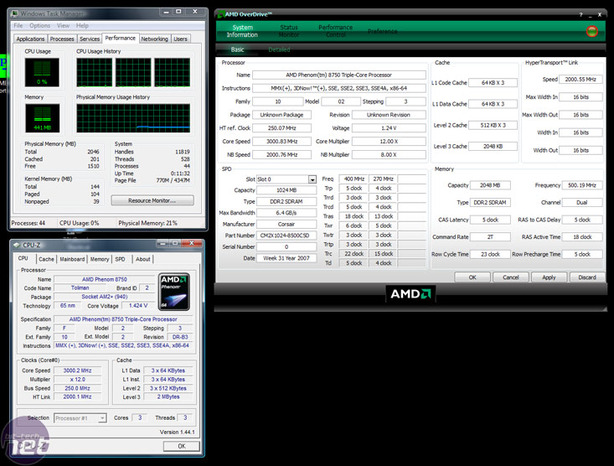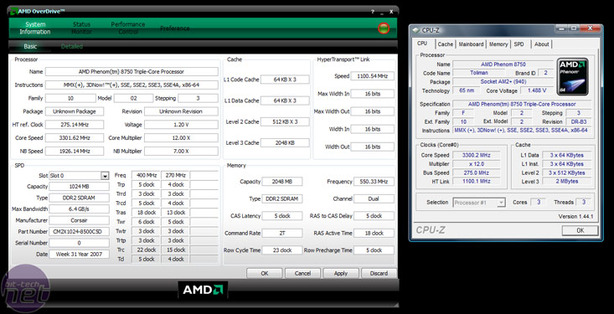Overclocking the Phenom X3 8750
The Phenom X3s that AMD is announcing today are all B3 cores which we already know will shift some, but the 8750 is a multiplier locked 95W part. That means you've got more thermal overhead to dive into, but at the same time you're limited to overclocking the HTT only.Thankfully unlike the original B2s, the B3s have a significant overhead to play with, although we do forewarn you that ideally you need a BIOS that can adjust the northbridge frequency independently for optimum results.
We tried ramping up the clocked speed on default volts first of all – this gave us about 2.6-2.7GHz: not bad for "free". We then pushed it up a little more to 240MHz HTT giving us a 2,880MHz core clock and a 2,160MHz north bridge clock. It needed a little more voltage at these frequencies, and in hindsight we were probably overzealous and unbalanced with 1.4V on the cores and nothing extra on the northbridge. Either way, it was stable but we wanted to push for more.
A few quick tweaks and we came to a round 3.0GHz stable at 1.425V, with at 250MHz HTT and the north bridge running on an 8x multiplier giving 2.0GHz at stock volts. Unfortunately it has no half multipliers and given that we wanted to benchmark with it, given past experience we weren't sure how long 2,250MHz on the north bridge and L3 cache would remain stable.
What was genuinely surprising was how cool this chip was. In the past, we've felt the need to suggest running the "yellow turbo mode" in AMD OverDrive on the Phenom X4s because the lack of total power down states when running in the "red turbo mode" caused about a 10˚C temperature increase. When overclocked, we could barely keep it cool on air even when using the beefiest of heatsinks we had available in the bit-tech labs.
In complete contrast we found the X3 at 1.425V across all cores would happily sit around 40˚C when using a Zalman CNPS9500LED. We didn't even need an additional fan on the heatpipes of our Asus M3A32-MVP Deluxe, which was definitely promising.
After we ran the entire set of benchmarks at 3.0GHz, exactly how high could this thing go? Well the light was fading outside and the air was cool(er) so we stuck the test system right by the window for some super-chilly high voltage action.
We topped out at 1.5V, with a 3.3GHz core clock and the HTT at 275MHz. That’s not bad, but as it idled at 50˚C it was obvious both the board and CPU required a lot more cooling to keep it happy – quite a bit more than just the couple of extra fans we'd thrown at it.
Focusing on the north bridge speed, we tried to increase this to see its direct impact on performance. Unfortunately it seems that this has a hard limit of just 2.2GHz – trying to set it above this caused it to automatically drop the multiplier. At least, that's what we think, while the multiplier is again locked to a maximum of nine the BIOS HTT was set so the memory and L3 cache would run at 2.4GHz, however AMD OverDrive said otherwise.
We're still remaining slightly sceptical until we get an updated OverDrive – some of the settings elsewhere don't correlate correctly and it can't recognise the package or processor revision of the X3 still.

MSI MPG Velox 100R Chassis Review
October 14 2021 | 15:04











Want to comment? Please log in.